Limited crowds, aggressive trout, and year-round fishing available for the first time in many decades. Ideal fishing for adventurous anglers who can handle cold weather
For many years, winter fishing in Yellowstone Park was something both locals and visitors could only dream about. The general Yellowstone Park fishing season runs from Memorial Day Weekend through October, forcing avid anglers to fish outside the park boundaries. For decades, no fishing at all has been available in the park from November through late May.
Starting November 1, 2024 (really May 25, 2024, when the 2024 general season opens), this all changes. Now sections of two rivers are opening to year-round fishing: the Madison River from the MT/WY state line near West Yellowstone downstream to the park boundary and the Gardner River from Osprey Falls to the confluence with the Yellowstone River. These rivers are both fed by hot spring basins, so they stay much warmer than waters elsewhere in the Rockies during the winter. This in turn keeps the trout and insects as active as they are during the summer. Active trout and active insects makes winter fishing in Yellowstone Park a better option than it is almost anywhere else in the entire Rocky Mountain West!
Overall, the Gardner will be the better bet, since year-round trout populations are higher than on the section of the Madison that is open.
Use this page to start planning your winter fly fishing trip, or check out our guided trips. You can also get in touch via e-mail with questions.
Note: fishing photos on this page were all shot either outside Yellowstone Park or inside the park immediately before the general season closed. Before 2021, this was the first Sunday in November. From 2021 through 2023, it was sunset on Halloween. Why no winter fishing pics from inside the park yet? Because it is only becoming legal next winter!

Late winter is prime time for larger rainbow trout as they prepare to spawn.
When and Where Does Winter Fishing in Yellowstone Park Occur?
Winter lasts a long time in the Rockies. It lasts even longer inside the park, which sits at high elevation. While there certainly can be warm days even in the dead of winter, especially at low elevations along the Gardner River near the north entrance to Yellowstone Park, for purposes of this page, winter fishing runs from November 1 through the Friday before Memorial Day Weekend in late May.
The general fishing season opens the Saturday of Memorial Day Weekend. While spring has certainly sprung at low elevations by late May, it’s possible for it to snow anywhere in or near Yellowstone Park into early June, and at high elevations deep snow drifts remain. Many lakes inside Yellowstone Park don’t even lose their ice cover until the last ten days of May or first week of June!
Inside Yellowstone Park, two rivers are currently opening for winter fishing. The Lower Gardner River near Mammoth Hot Springs and Gardiner is accessible year-round via road. The Madison River from the MT/WY state line near West Yellowstone downstream to the park boundary and beyond is accessible throughout the winter via snowshoes or skis. Limited year-round access is possible near West Yellowstone via vehicle. Easy road access is available starting in mid-April when Yellowstone Park interior roads open to auto traffic.
We expect winter fishing in Yellowstone to be available on the Firehole and Gallatin Rivers beginning in 2026, and possibly on portions of the Yellowstone and Gibbon Rivers. The Firehole and Gibbon Rivers will have similar access as the Madison, while the Gallatin is accessible via US-191 year-round. The Yellowstone would have limited access in the dead of winter, but in late autumn and from March onward, limited snow cover will allow for some access via short hikes. We will update this page when/if these rivers inside the park open to year-round fishing.
Year-round fishing opportunities are also available near Yellowstone Park. Ice is a limiting factor from late November into March, but some options are available year-round to mix things up, rather than fishing only within the park.
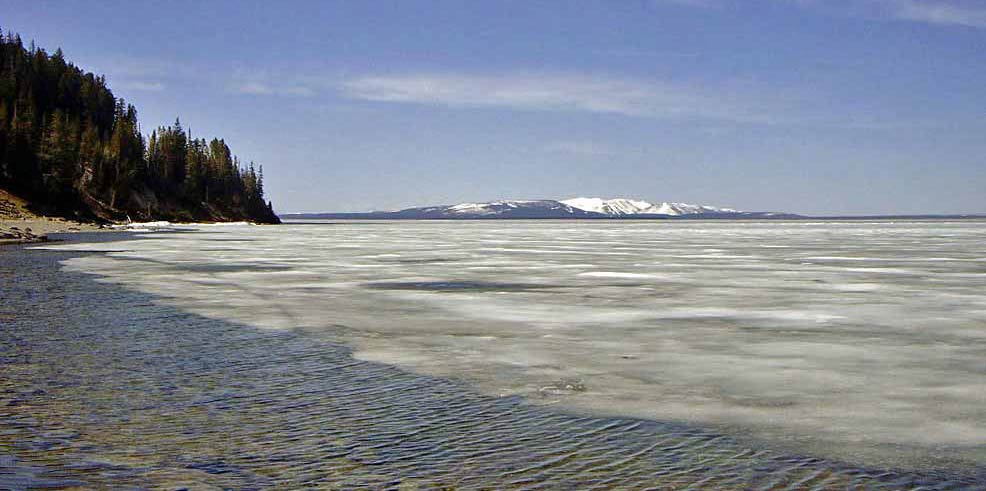
Winter runs late in Yellowstone Park. This is Yellowstone Lake on approximately May 25, still mostly frozen.
Guided Trips
We have been fishing the Yellowstone region since 1993 and guiding the region since 2001. In fact, Walter Wiese has been guiding the Gardner River longer than any other currently active guide or outfitter. We’d love to help you cut the learning curve for winter fishing in Yellowstone Park on one of our guided trips.
We are based in Livingston, Montana. As such the Gardner River is our main winter destination inside the park. We love fishing it all the way from November through May. In fact, we guide on this river almost year-round. We also guide on the Yellowstone River and Paradise Valley Spring Creeks outside the park during the winter. March and April are prime time for these waters. The Lower Madison River near Bozeman joins the party in May, as do private lakes.
All of our trips within Yellowstone Park are walk-wade trips. We run float, float-wade, and walk trips in Montana. In the heart of winter, from November through March, we suggest half-day guided trips. During April and May, full-day trips also make sense, especially on float trips or when we’re driving to the Madison inside Yellowstone Park.
If you’re staying in Big Sky or West Yellowstone prior to mid-April, numerous guide services and fly shops are available and run trips both in Yellowstone Park and in Montana during the dead of winter.
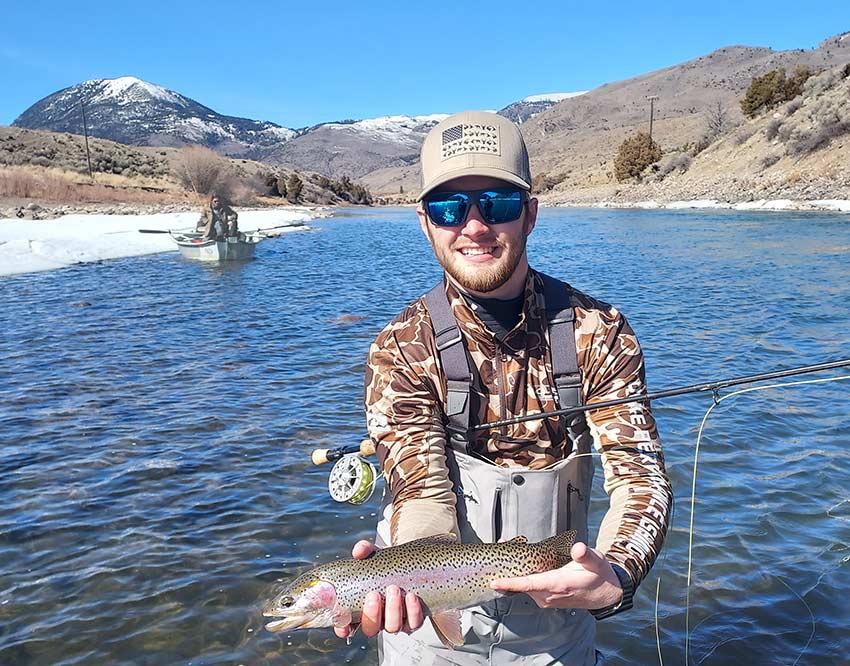
While walk-wade guided trips are available all winter, floats become good options sometime in March. This was our first guided float of the year in 2022.
Winter Fishing on the Gardner River
Introduction to the Gardner
The Gardner River is Yellowstone Country Fly Fishing’s “home” water within Yellowstone Park, and it’s also the best year-round fishery in the region. It is where we will do most of our winter fishing, and a lot of our summer fishing, too. It’s where we will run more than 90% of our winter guided trips inside of Yellowstone Park. While it’s good all winter, peak periods are in November and early December, than from February through April.
The new regulations allow year-round fishing anywhere between Osprey Falls and the Gardner’s confluence with the Yellowstone River adjacent to the town of Gardiner, a distance of roughly ten miles. Osprey Falls is a remote waterfall several miles into the backcountry. While fishing near this waterfall is good in the summer, in practical terms, winter fishing really begins near the “high bridge” east of Mammoth Hot Springs. The Gardner leaves Sheepeater Canyon half a mile upstream of this bridge, and the larger amount of sunlight that hits the river from here down allows for more insect activity and active trout.
This trend is supercharged at Boiling River about four miles upstream from the river’s mouth. Boiling River is a large hot spring that pumps in hundreds of gallons of warm water per minute. During low water periods (including winter), this spring increases the Gardner’s flow by 25% and also adds lots of nutrients. Upstream, the Gardner is a classic mountain stream and will freeze during the heart of winter. Downstream, it never freezes, there are lots of aquatic weeds, and bugs and fish stay active even when air temperatures are well below zero.
The Gardner has a mixed bag of fish species. Rainbow trout and brown trout dominate the population in this stretch, but there are a few brook trout upstream from Boiling River, as well as native cutthroat and hybrids between rainbows and cutthroats. Whitefish are also common, some of which can get quite large. Mountain suckers are also present, but uncommonly caught.
Resident trout in this stretch of the Gardner average from 8 to 14 inches. Spawning migrations of brown trout running from the Yellowstone River occur from September through November, with the peak spawn occurring in early November. Some of these browns remain until March. These fish average 14 to 18 inches, often reach 20 inches, and have been known to reach trophy size. Some rainbow trout follow the browns to gobble their eggs. These also average 14–18 inches and very occasionally reach 24 inches. More rainbows enter beginning in February. They spawn in April and early May and sometimes remain through May.
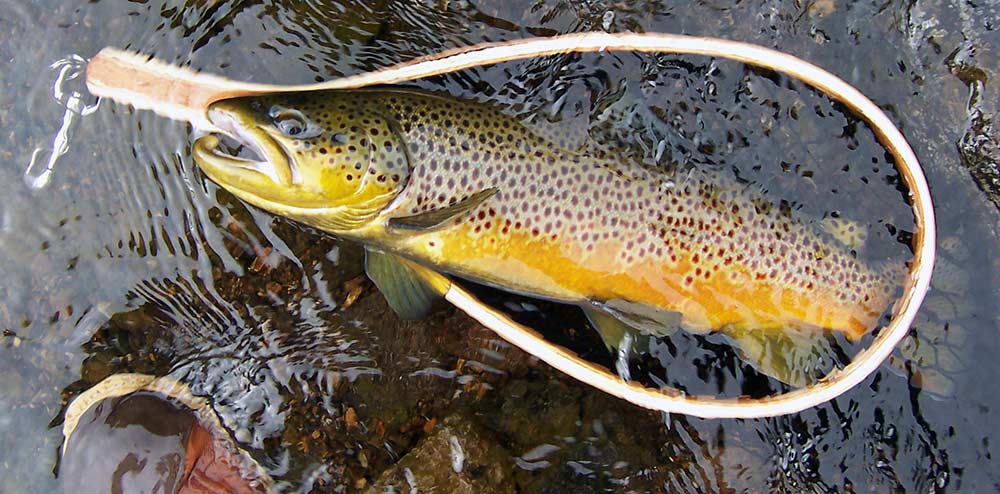
Large fall-run brown trout are popular quarry on both the Gardner and the Madison.
Where and When to Fish
The Gardner has something of a split winter season due to the influence of Boiling River. Upstream from this hot spring, the water will be too cold in the heart of winter. In fact the river often freezes. Warm afternoons in early November and April and May will offer the best fishing on this stretch. Downstream from Boiling River, the fishing is good throughout the winter. The colder the weather and water, the better the fishing near the hot spring itself.
This entire stretch can suffer from snowmelt, particularly when warmups occur in November and again in April and especially May. The banks of much of the lower Gardner are very steep and covered in clay soils, so when the snow melts, it brings in muddy water. These runoff problems get progressively worse the further downstream you travel, since more and more mud can wash in the further downstream you go. These periods of murky water are short on the Gardner, so even a couple cooler days will shut off the muddy water taps even in May, when the heavy spring melt occurs.
Gardner River – Winter Highlights
- Fall-Run Brown (and some Rainbow) Trout: The brown trout spawn begins on the Gardner around October 20 and may continue into early December, with peak spawning activity in early November. While directly targeting active spawners is unethical, fishing for pre-spawn and post-spawn fish as well as resident trout in the deep holes downstream of spawning activity is ethical and can offer exceptional fishing. When the Gardner closed at the end of October, I (Walter Wiese, YCFF’s owner) always finished my park season on the Gardner. This fishing now continues through November and trails off slowly in December. Warm periods in November can be good above Boiling River, but the heart of this fishing is downstream of Boiling River.
- Winter Midge and BWO Hatches: The Gardner sees sporadic flurries of BWO mayflies beginning in September above Boiling River. The best hatches are from mid-October through Thanksgiving and in March and early April below Boiling River, then in April and early May above. These hatches tend to be localized. Some holes produce, while others nearby do not. To target these hatches, I carry a Tenkara rod rigged and ready in the back pocket of my vest or pack, even while I’m otherwise nymph-fishing. When I see rising trout, I set down the nymph rod and break out the Tenkara. The BWO hatches fade but never quite disappear through the winter. The main hatches from December through February are midges, which demand similar tactics as the BWO.
- Winter Nymphing: During the heart of winter (December through February), the Gardner River offers the best nymphing in the region. This is due to the river’s warm water, which keeps the trout active. Both indicator and “Euro” tactics can work on the Gardner. During the coldest periods, hit the deepest, slowest pools. When the water warms a bit, don’t hesitate to fish the fast pocket water. Near Boiling River the water will be more than warm enough for the trout to remain in swift water.
- Pre-Spawn Rainbow Trout Fishing: The spring rainbow trout run echoes the fall brown trout run. While the brown trout run has received heavy pressure for decades, the rainbow trout run has historically been unavailable due to the old closed season. Better yet, the late winter and spring crowds will never match those that hammer the browns in September and October. The rainbow run occurs from late February through early May, occasionally extending almost to June. This fishing is best below Boiling River, but will extend upstream in April.
- Mother’s Day Caddis Hatch: Another late winter highlight is the Mother’s Day Caddis hatch. Downstream of Boiling River, these insects may hatch sporadically in early April, but late April is prime time. Upstream of Boiling River, look for them on days the water is clear during the first three weeks of May.

The lower Gardner River remains relatively snow-free and produces fall-run brown trout into December.
Winter Tactics and Tackle
The Gardner River is primarily a nymph-fishing river and has huge stonefly populations. As such, a relatively stout nymphing rod is your go-to here. I like a 9′ 6-weight in standard rods or a 10’6″ 4-weight Euro-nymphing rod. During the coldest part of winter, you might get away with a 9′ 5-weight given that midge larvae/pupae and BWO are most important then. Floating lines are all you need when nymphing, and leaders should be tapered to 3X when fishing stoneflies or 4X–5X if using smaller flies.
In November and early December and again from late March through early May, streamers can be productive in the larger pools. A fast-sinking Polyleader is sufficient to get your streamers deep. There’s no need for a dedicated sink-tip.
For dry fly fishing, either a standard 9′ 5–6wt fly rod or a Tenkara rod works well. I tend to carry the Tenkara rod to go with my Euro-nymphing rod, but swapping to a lighter leader on your normal rod is fine too.
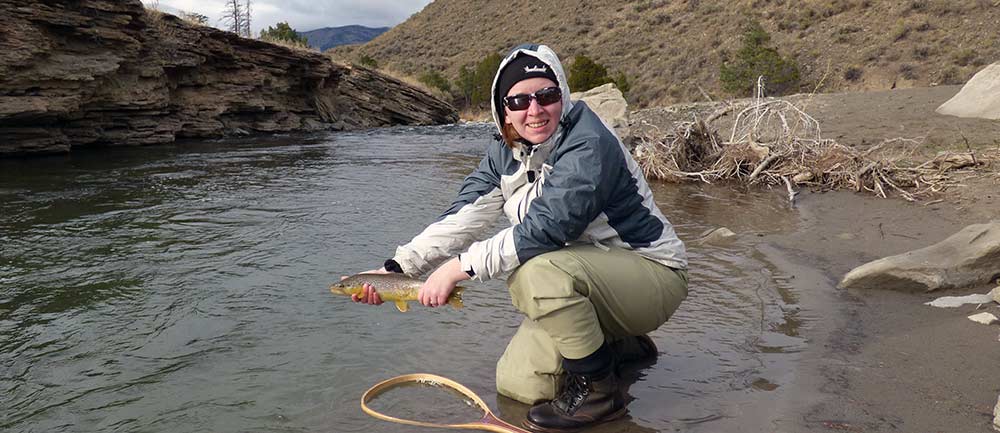
Late fall brown trout caught by the author’s wife
Winter Flies
Top flies on the Gardner during the winter include the following categories and specific patterns:
- Stonefly Nymphs: Stonefly nymphs are the bread and butter flies on the Gardner. There’s no reason to get complicated. Fish #6–12 Girdle Bugs in tan/black, brown, or coffee/brown. The Tunghead 20-Incher in #10–12 is also good, as is local favorite the Minch’s Golden Stone. It also makes sense to fish the TJ Hooker, which is a stonefly/streamer combo, since it can be twitched a bit as well as fished dead-drift. These flies are useful all winter (actually all year). Opt for larger ones in November and April–May and smaller ones during the heart of winter.
- Attractor Nymphs: Slightly smaller attractor nymphs like Minch’s Bead, Hare, and Copper and Princes are good bets in November and April–May. During the heart of winter, opt for Red Copper Johns and “flashy” mayfly-style nymphs like Lightning Bugs. Don’t hesitate to fish pink mayfly nymphs such as pink Lightning Bugs. Larger and more-generic attractors with elements of pink such as the Pink Squirrel are also good. Attrator Nymphs should be #12–16 in November and April, but often #16–18 otherwise.
- BWO Nymphs: Dedicated BWO nymphs are often better than attractors during the dead of winter. Fish #16–18 Pheasant Tails or Micro Mayflies. Don’t hesitate to try attractors in the same sizes instead. The WD-40 is also a good bet, especially when there are both midges and BWO active.
- Subsurface Midges: Midge larvae and pupae on the Gardner can be simple. #18 Zebra Midges in black are a good starting point, and may be all you need. Juju Midges, Miracle Nymphs, and the WD-40 are also good choices. Unlike most places in the Rockies during winter, subsurface midges are not the bread and butter flies except perhaps in late December and January.
- Egg Flies & Worms: Eggs and worms are excellent choices on the Gardner during the winter. Eggs are most important in November and early December (during and just after the brown trout spawn). They’re also important again in March and early April (during the rainbow spawn). Fish Glo-Bugs or similar “traditional” eggs, Y2K eggs, or Eggstacy yarn eggs. All should be #16 and generally pale pink or apricot in color, though chartreuse can also work on cloudy days. Worms are most important during bouts of snowmelt in April and May, but can likewise be good all winter. Fish smaller, more slender worms from December through February and slightly bigger ones otherwise. I like Flexi Floss Worms in #16–18 in the heart of winter and traditional San Juan Worms or my Triple Threat Worm (formerly White River Worm) in #12–16 in November and April–May. The latter pattern is especially good in April and May when the river is getting dirty. Worms can vary in color, but the old standby reds and pinks are usually best except in the case of the Triple Threat. This worm is red, black, and brown. Note that Squirmy Wormies and similar soft plastic worms are not legal in Yellowstone Park (they are considered bait).
- Dry Flies: Since the Gardner is a rough river, even the small insects common in winter can be matched with fairly visible and high-floating flies. For midges, all you are likely to need are Griffith’s Gnats in #18 and perhaps black or olive Parachute Midge Emergers in #18–20. BWO can be matched with mayfly-type attractor dries in the appropriate size. I prefer Purple Hazy Cripples or Upbeat Baetis in #18–20. If these patterns don’t work, a slightly drabber fly such as a Hi-Viz Gray Baetis or Sparkle Dun in #18–20 will usually do the trick. The occasional March Brown (which will appear in April) can be matched with #12 Brindle Chutes or Sparkle Duns. Mother’s Day Caddis are best matched by Coachman Clacka Caddis or Peacock Caddis with a green caddis pupa on the dropper.
- Streamers: Since it is so rough, the Gardner is not a great streamer river. That said, Woolly Buggers in assorted colors (including vivid ones like black and orange combos, aka “Halloween”) are good choices in spring and fall. So are flash streamers like the Kreelex. Fish these in #4–8 in the larger pools and runs only. Note that articulated streamers are not legal in YNP unless you remove one of the hook points.
Winter Fishing on the Madison River in the Park
Introduction to the Madison
The Madison River forms at the junction of the Gibbon and Firehole Rivers. It then flows west parallel to the park’s West Entrance Road almost to the West Entrance. Here it hooks north-northwest and flows parallel to the park boundary (actually straddling the boundary) before turning west again. Shortly downstream it enters Hebgen Lake. The portion of the Madison currently open year-round begins where the river hooks northwest, at the WY/MT state line. See the map below.
Access is much more difficult on the Madison than it is on the Gardner, for one simple reason: snow. West Yellowstone gets completely buried in the winter, and the Madison typically has feet of snow along its banks from December through late March. This means that snowshoes or skis will be required to reach the river. Compounding access issues is the fact that the West Entrance Road is closed to all vehicle travel from November 1 through mid-December and again from early March until mid-April. From mid-December through early March, access is only possible on snow coaches or snowmobiles, and even these vehicles have tight restrictions inside the park boundary.
These access difficulties make the Madison primarily an early and late winter fishery, with November the best month. The road opens to cars on a Saturday in mid-April (generally the 15th–20th). The fishing is excellent from this point until at least mid-May. Sometimes spring runoff is heavy enough to turn the river unfishably high and muddy from mid-May until early June, though this is becoming less common due to global warming lowering overall snowpack.
The portion of the Madison currently opening to year-round fishing has limited year-round trout populations. Instead, the fishing depends on seasonal spawning runs. The trout pass through this area of the Madison on their way to spawning areas higher in the river system. The brown trout runs begin in late August and are most intense from early October until Thanksgiving. Some rainbows also run in the fall. The heaviest rainbow run occurs from February through early April.
Where and When to Fish
Winter fishing opportunities on the Madison inside the park are honestly very limited. If the entire Madison was open, this would not be the case. The portion near West Yellowstone that is open can be quite good, but only for experienced anglers looking for a few larger fish. Beginners or those looking for numbers are better off elsewhere.
The portion of the Madison open year-round runs from MT/WY state line downstream to the park boundary and beyond. This is a total distance of about eight miles as the crow flies, around 5mi of which is inside YNP. Portions near the downstream end of the YNP reach actually crisscross the boundary line. It’s a good idea to have a MT license as well as a YNP license if fishing upstream from the downstream access points near Baker’s Hole Campground (outside the park).
This stretch of river is a sinuous series of bends, pools, and old channels. Since most of the fishing is aimed at pre-spawn trout on their migrations, the turbulent runs and deep pools are where you should concentrate your attention. Almost no fish will be found in the fast, shallow sections.
Madison River – Winter Highlights
- Fall-Run Brown (and Some Rainbow) Trout: The Madison’s fall runs have been famous since the 1950s. Now the season is extended through the entire run. These runs begin with a trickle in late August, intensify through September, and are at their peak in October and early November. They trail off through November as the late runners head upstream or bed down to spawn; not many fish will remain in the coldest part of winter.
- Spring-Run Rainbow Trout: While some rainbows run with the browns in the fall, most begin their spawning migrations in late winter. Their numbers are highest in February and March, then trail off through April.
Winter Tackle & Tactics
Winter fishing in Yellowstone Park on the Madison is centered on targeting large trout on their spawning migrations. Therefore, tackle and tactics are very different than on the Madison compared to the Gardner.
Rods should be stout. 9′ or 10′ 6–7wt rods are best if you’re using a conventional single-hander. 4wt and 5wt switch and spey rods also make sense here, especially when fishing streamers. You should have floating and sink-tip lines or polyleaders for all outfits. Leaders should taper to no lighter than 3X tippets, and heavy streamer tippets such as 12lb Maxima are sometimes suitable.
Winter Flies
- Stonefly Nymphs: When nymph-fishing this stretch of the Madison, you should usually run an impressionistic stonefly as your heaviest pattern in a two-fly rig. Brown, tan/black or coffee/black, and even black and orange Girdle Bugs in #4–6 are good starting points. So are TJ Hookers in the same colors and slightly smaller sizes. Other local favorites include Brooks Stones and Minch Stones, and this is one place where I like a black or peacock Bomb Stone as well.
- Attractor Nymphs: Attractor nymphs here should be substantial gobs of protein in their own rights, most of the time. Fish #10–14 Minch’s Hare & Copper, large Princes or Copper Johns, and similar “buggy” nymphs behind your stonefly. In midwinter and early spring, Pink Squirrels or Rainbow Czechs in the same sizes are good, and somewhat smaller pink Lightning Bugs are also worth a shot.
- Streamers and Wet Flies: Streamers and large steelhead-style soft hackles are the traditional choices on the Madison. Woolly Buggers and Muddler Minnows are classics and still work. Local favorites are more evocative of traditional West Coast steelhead flies. These include the Gartside Soft Hackle (which resembles a drabber Popsicle or similar steelhead fly) in numerous colors, as well as traditional bucktails like the Mickey Finn or Black-Nosed Dace. In the past 10–15 years, many local patterns have filled this niche. These include the Shakey Beeley, Blue on Blue, September Song, and numerous others. While Woolly Buggers and the like can run #2–6, the patterns more evocative of wet flies should run #6–12. Fish all of these flies on the swing in the wider runs, or strip them through the undercuts.
- Egg Flies & Worms: Egg flies and worms are good substitutes for your attractor nymph and fill the same roles. Fish similar egg flies as mentioned for the Gardner. Worms can run bigger. Red or burgundy “Pig Stickers” (aka Wire Worms) are popular choices, as are extremely large San Juan Worms in red, pink, and wine.
- Dry Flies and Imitative Nymphs: Opportunities to fish dry flies are limited on this stretch of the Madison. You will occasionally find trout rising to midges or BWO in the winter. If you encounter these situations, use similar flies as mentioned above for the Gardner. Likewise, match-the-hatch nymphs are usually not a great choice. Carry some Pheasant Tails and Zebra Midges anyway.
Winter Fishing in Montana Near Yellowstone Park
Fishing inside Yellowstone Park during the winter is only part of the story. The fishing can also be very good in Montana near Yellowstone Park, without the summer crowds, especially from sometime in March through May. In Yellowstone Park this period still qualifies as winter, but at lower elevations in Montana, it’s definitely spring.
There are few hot springs to warm up the water outside of Yellowstone Park. For this reason, water temperatures are the primary driver of fishing outside the park during the winter. If they are too cold, the fish will be lethargic. There might even be too much ice to reach the water, especially if you’re looking to float. Because of this, the heart of winter is better inside the park than it is in Montana. Good options during the coldest part of winter (or cold snaps early and late in winter) are limited to spring creeks and areas of larger rivers with hot spring or warm river inputs.
By March, the ice begins receding from all larger rivers, and all are very good from this time until they are struck by spring runoff sometime in May. April in particular is an excellent time to float-fish the Yellowstone River for larger trout. The Madison River is a better bet in May. For both rivers, March and April are great times to fish if you’re looking to avoid the heavy summer crowds on these rivers. Why not combine a day of wading the Gardner or Madison inside the park with a day of floating outside?
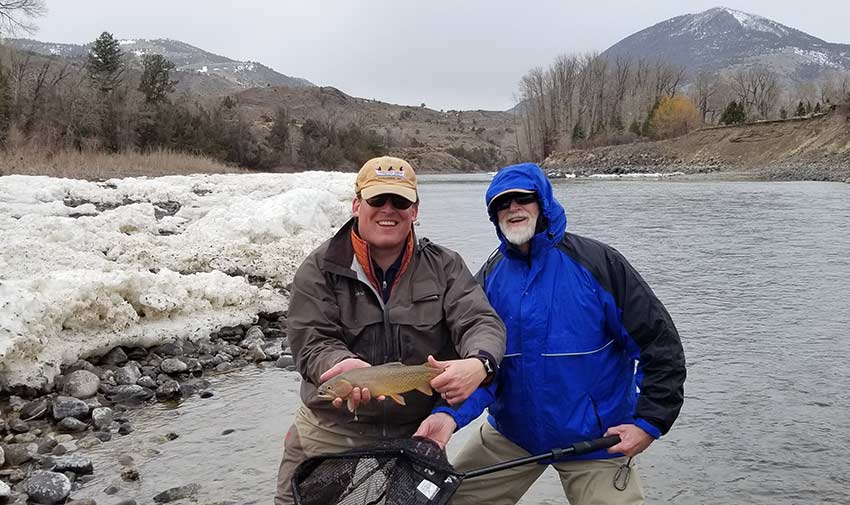
Float trip cutthroat. Believe it or not, this photo was shot in April.
Good Montana Winter Fisheries Near YNP
For more details on these fisheries, including fishing tips & info, please check the Our Fisheries and Trip Planning sections of our site. Since Montana fisheries are and have been open year-round for a long time, we provide lots more fishing info for these waters in the “normal” portions of our site, rather than this dedicated page.
- The Paradise Valley Spring Creeks: These three private spring creeks (Depuy, Nelson, and Armstrong) are the only Montana waters near Yellowstone that are always warm enough to fish through the winter. They are fee-access fisheries, but the winter rates are much lower than during the peak summer season. As of this writing, winter rates (valid mid-October until mid-April) are $40–45 per angler per day. The best towns to stay in to fish these creeks are Livingston, Emigrant, and Bozeman, in that order.
- The Yellowstone River: The Yellowstone River can be good in some areas even in the coldest parts of winter. This is due to the influence of the warm Gardner River as well as a few hot springs. Large portions of the river freeze, but the warm stretches near Gardiner always stay ice-free. That said, the best fishing on the Yellowstone during the winter is in November and especially from March until early May. During the latter period, spring has definitely sprung at these low elevations. April float trips in particular can be very productive, without summer crowds.
- The Madison River: The entire Madison River outside YNP is open to fishing year-round, and it can fish at least fair whenever it is warm enough for you to stand it. Popular stretches in the winter are the “between the lakes” stretch between Hebgen and Quake Lakes, the “slide section” in the first few miles below Quake Lake, and the Lower Madison west of Bozeman. Float fishing begins on the Madison in late March or April. The Lower Madison is definitely the star of the show for spring float fishing.
- The Gallatin River: The Gallatin River is probably the most popular midwinter fishery in the region, not least because it is bookended by Big Sky and Bozeman, the region’s hubs for skiers and snowboarders. The best portion of the Gallatin in the winter is found downstream from Big Sky. Here a few hot springs as well as warm (treated, although sometimes not well) wastewater from Big Sky keep the river mostly ice-free. Upstream of Big Sky and near Bozeman, ice is common. March and early are the most popular times for tourists to fish this water. Ski in the morning, fish in the afternoon. The proximity to Bozeman means local traffic is heavy all winter. On warm weekends, it’s not uncommon for every pullout on US-191 (which closely follows the river) to have a car in it. The Gallatin remains good into early May, when the spring melt hits.
- Private Lakes: The low-elevation private reservoirs lose their ice in late March or early April. Once this occurs, fishing can be very good in the sun-warmed shallows for trout seeking to make up for a long winter. Access can be tough, however. Some lakes require guides, while others have rough access roads suitable only for high-clearance 4wd vehicles. Even these roads may be muddy, rutted, and even covered with impassable snowdrifts into late April.
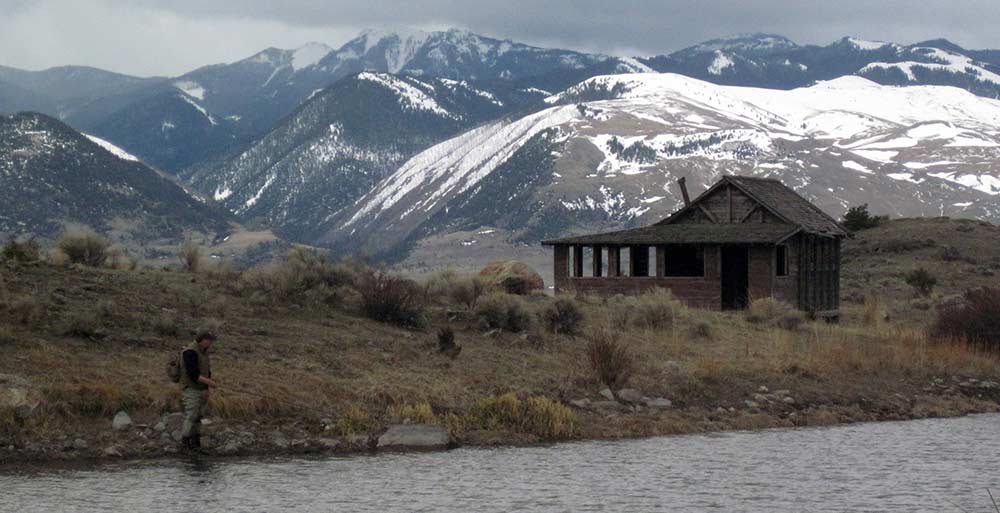
Private lakes become available near Yellowstone Park in April. We had to ram a snow drift to reach this lake.
What to Wear
Winter in Yellowstone Country can be very rough, but it can also be bright and (relatively) warm. The weather in April and May at low elevations can often be very pleasant, with highs in the 60s–70s and sunshine, though even this late in the year, snow is possible even in low-elevation cities like Livingston and Bozeman. In fact the mountains typically receive more snow in April than they do in February.
This means that it’s important to come prepared for changing weather conditions. we suggest combinations of the following clothing and wading gear:
- synthetic base layers (top and bottom) in medium and heavy weights from late November through February and medium and light weights otherwise
- Fleece or down jackets and/or vests as midlayers
- heavy-duty waterproof shell jackets, either fishing wading jackets or just hardshell winter parkas
- fleece pants to wear over base layers, particularly from late November through February (otherwise, lightweight outdoor pants are fine)
- neck gaiter or scarf
- warm hat or cap, as well as a ball cap or other fishing hat
- neoprene or fleece fingerless gloves
- neoprene mittens or full-finger gloves (if you can tolerate fishing in conditions when these are necessary)
- heavyweight wool or synthetic socks for wear under waders
- breathable or neoprene waders
- wading boots with rubber soles – you may add aluminum traction aids if desired; tungsten carbide studs are too hard to help on our extremely hard rocks
Other Things to Do
Winter isn’t an ideal time of year to fly fish all day long in the Yellowstone area. Even on the geyser-heated water, the fish will be lethargic first thing in the morning from late November until at least mid-April, and even in May the fishing will be better in the afternoons. Thankfully, there are plenty of other things to do in the winter.
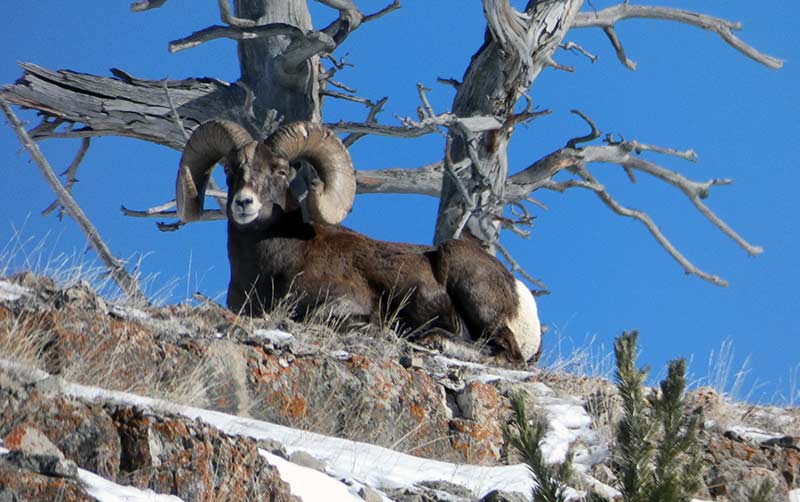
Wildlife watching is excellent in winter.
Skiing and Snowboarding
Skiing and snowboarding are the obvious pairing with fishing. Both alpine/downhill and cross-country skiing are available. We don’t recommend cross-country snowboarding…
While there are established XC ski destinations in the area, both Yellowstone Park and many National Forest trails offer excellent options for those who have their own gear or rent from one of the many rental shops in Livingston, Gardiner, West Yellowstone, and Big Sky.
Alping skiing and snowboarding are the heart of the region’s winter activities.
- Big Sky is the largest, most famous, and most expensive area resort. It is within reasonable range of the Madison River both inside and outside Yellowstone Park, as well as the Gallatin River.
- The local favorite is Bridger Bowl. Bridger is just 16mi from Bozeman and much cheaper than Big Sky. It still boasts extreme terrain, abundant snowfall, and a “big mountain” feel. If you want to ski Bridger Bowl, staying in Livingston, Bozeman, or Gardiner. This will allow you to fish almost everywhere that’s good in the winter while minimizing drive time. The exception is the Madison in the park.
- Red Lodge is the other big area resort. While too far from our good winter fisheries, it is close enough to visit for a couple days combined with a winter fishing in Yellowstone trip. They tend to have great late season snowfalls in early April!
Snowmobile & Snow Coach Trips
Snowmobiling is popular for those who like motorized recreation. West Yellowstone is the heart of these trips, since wheeled vehicles (aka cars) are not allowed into the park interior between November 1 and mid-April. Snow machines can start right from town. Big Sky is also a good destination for snowmobiling, as is Cooke City at the park’s northeast corner. Cooke in particular has limited nearby winter fishing opportunities, however.
Snowmobiling is possible both inside Yellowstone Park and on developed public trails outside the park. Note that there are significant restrictions on the snowmobile makes and models that are allowed inside the park. Snowmobiles also must stay on the roads to minimize impacts on wildlife.
Snow coach trips are for those who want a slower-paced trip. Most coach trips occur in Yellowstone Park and are focused on sight-seeing as well as wildlife watching. Speaking of which…
Wildlife Viewing
Wildlife Viewing is prime in the winter, especially if you’re hoping to see wolves. Bears begin coming out of hibernation in late March or early April and are likewise extremely visible thereafter. With prey animals clustered in the valleys in the northern part of Yellowstone Park, it’s easy to combine a morning of critter watching with an afternoon of fishing on the Gardner River inside the park or the Yellowstone River outside.

Sightseeing and General Tourism
Sightseeing opportunities inside Yellowstone Park are limited in the dead of winter compared to the rest of the year, unless you access the interior of Yellowstone Park via snowcoach. Most YNP amenities and famous sights are closed or simply inaccessible since the roads are closed to cars from November 1 until mid-April. Only the geyser basins at Mammoth Hot Springs are accessible during this period. Visitor centers are open from mid-December through early March. Many close during the “shoulder seasons” in November and early December and early March through mid-April.
From mid-April onward, sightseeing opportunities open up quickly as the YNP interior roads reopen and the snow starts melting off trails. Many popular attractions including Old Faithful and other geyser basins in the vicinity become accessible as soon as the roads to them open, and crowds are far lower from mid-April until mid-May than they are during the core tourism season afterwards. If you want to combine Yellowstone Park sightseeing with winter season fishing, we suggest late April.
Through the winter, museums in Livingston and Bozeman provide indoor activities for those days when you need to warm up. The Museum of the Rockies in Bozeman is a particular treat. It holds one of the largest dinosaur collections in the world.

Where to Stay
The towns that make the most sense for winter fishing in Yellowstone, or near it, as well as other winter activities, are:
- Gardiner, Montana: Best for fishing on the Gardner River, Yellowstone River, and Paradise Valley spring creeks, wildlife watching, general Yellowstone tourism from November through May, and XC skiing or snowshoeing in YNP.
- Pray/Emigrant, Montana: Fair for all of the above except very good for fishing the Yellowstone River and spring creeks. Also a fair choice for skiing/snowboarding at Bridger Bowl.
- Livingston, Montana: A great place to stay to be centrally located to do just about everything. I live in Livingston, and I can be fishing, skiing, wildlife watching, or doing anything else anywhere mentioned on this page within about 2hr, and usually less than an hour. Ideal if you are hoping to mix a skiing, fishing, and sightseeing trip from November through mid-April.
- Bozeman, Montana: Best for skiing at Bridger Bowl and fishing the Lower Madison River and Gallatin River. Fair for fishing elsewhere and skiing at Big Sky, but too far for YNP sightseeing or wildlife.
- Big Sky, Montana: Best for skiing at Big Sky and fishing the Gallatin River. Good for snowmobiling as well. Fair for fishing the Madison River. Too far from everything else.
- West Yellowstone, Montana: Best for fishing the Madison River in and near YNP, as well as snowmobiling. Fair for skiing at Big Sky and fishing the Gallatin River. Too far for everything else except after mid-April when the YNP roads open and allow for wildlife watching and sightseeing.
Conclusion
While there have always been winter fishing opportunities near Yellowstone Park, the recent change to regulations mean some of the best waters in the park are now available year-round. We hope this page and the information on our website are helpful for planning winter fishing trips. Beat the crowds and have a great time. We’d appreciate it if you’d consider booking a guided fishing trip with us, or suggesting others do the same.